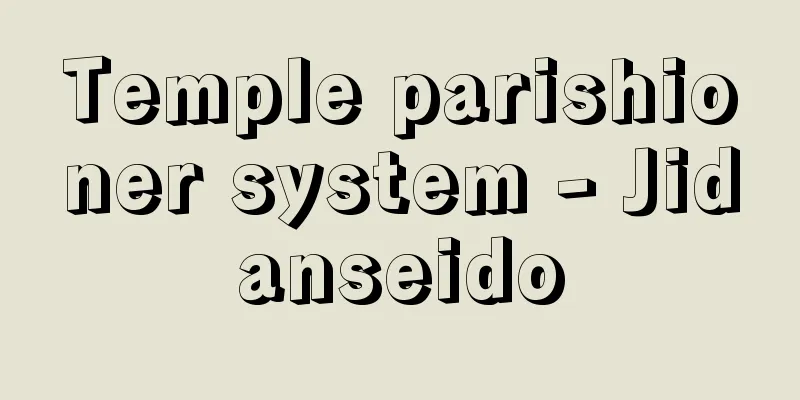Temple parishioner system - Jidanseido

|
It is also called the danka system or terauke system. It is based on the temple-parishioner relationship in which a specific temple is permanently in charge of the funerals of a specific family (parishioner) and receives donations from them, and the system requires parishioners to prove that they are not Christians by being listed in the danka or shujinbetsucho register. It began as a religious control system under the Edo Shogunate, and had the characteristics of a family registration system. Donna (a Buddhist donor) and danko (a Buddhist donor) making donations to a specific temple priest have been seen since the establishment of Buddhism, but the relationship between a family and a family temple that began among nobles and samurai families became widespread in the early modern period, and temple-parishioner relationships were generally formed by making these families parishioners. Meanwhile, the Edo Shogunate implemented measures to ban Christianity and issued orders to reform Christianity, which various feudal domains implemented in various ways, including the Obama domain in Wakasa (Fukui Prefecture) that collected religious documents from temple-parishioner temples in 1635 (Kan'ei 12), which used temple-parishioner relationships to reform Christianity. In this way, the temple registration system was started during the Kan'ei period (1624-1644), but religious reforms were also carried out using the personal registers that had been compiled separately. When the shogunate institutionalized this in 1671 (Kanbun 11), the system of temple registration based on the personal registers was established. This fixed the relationship between temples and parishioners, and as a rule, changing temples or sects was no longer permitted. When people left their birth home to get married or enter into an indentured service, they had to show a temple invoice (religious document) from their parishioner's temple to prove their identity, and the system gradually took on the character of a family registration system. As a result, so-called "half-parishioners," who had different parishioners' temples within the family, did not fit into this system, and some feudal domains ordered a change to a temple-parishioner relationship of one family and one temple in the mid-modern period. Moreover, for temples, the institutionalization of temple-parishioner relationships created stability in their management, so they worked to maintain and strengthen them. The famous "Rules for Accepting Patronage in the Sect," written in the name of Tokugawa Ieyasu, is said to have been established around the Kyoho period (1716-1736), and contains phrases such as those who do not pay parishioner duties (donations and fundraising) or do not perform annual memorial services for their ancestors being considered Christians, clearly illustrating the relationship between temples and parishioners. Even after the collapse of the Edo Shogunate, the compilation of shujijinbetsucho (registers of religious beliefs and personalities) continued until the family registration system was established in 1871 (Meiji 4). After the shujijinbetsucho (registers of religious beliefs and personalities) was abolished, Buddhist religious organizations maintained temple-parishioner relationships as the foundation of their organizations, and because the Meiji Civil Code codified the family system, temple-parishioner relationships have continued to exist to the present day. [Hitoshi Okusa] [Reference] |Source: Shogakukan Encyclopedia Nipponica About Encyclopedia Nipponica Information | Legend |
|
檀家(だんか)制度、寺請(てらうけ)制度ともいう。特定の寺院が特定の家(檀家)の葬祭を永続的に担当して布施(ふせ)を受ける寺檀関係を基礎とし、寺請や宗旨人別帳への記載によって、檀家の人々がキリシタンでないことを証明させる制度。江戸幕府の宗教統制として始まり、戸籍制度の性格をもっていた。 特定の寺僧へ布施を行う檀那(だんな)・檀越(だんおつ)は、仏教の成立以来みられるものであるが、公家(くげ)や武家に始まった家と菩提寺(ぼだいじ)の関係が、近世初頭に民衆の家が広範に成立すると、これを檀家とすることによって、寺檀関係が一般的に形成された。一方、江戸幕府はキリシタン禁制策をとり、キリシタン改(あらため)を指令したので、諸藩はさまざまな方法でこれを実施したが、このうちには1635年(寛永12)に若狭(わかさ)(福井県)小浜(おばま)藩が、檀那寺の宗旨手形を徴収したように、寺檀関係をキリシタン改に利用するものもあった。このようにして寛永(かんえい)期(1624~44)には寺請制が始められたが、これとは別に作成されていた人別帳を利用した宗門改も行われ、1671年(寛文11)幕府がこれを制度化すると、宗旨人別帳による寺請の制度として確立した。 これによって寺と檀家の関係は固定化され、寺替(てらがえ)・宗旨替は原則として認められなくなった。婚姻や年季奉公などで生家を離れるときには檀那寺の寺送状(宗旨手形)をもって身分を証明されねばならなくなり、しだいに戸籍制度としての性格をもつようになった。そのため、家族のうちで檀那寺を異にするような半檀家とよばれるものなどは、この制度にふさわしくなかったから、藩によっては近世中期に一家一寺の寺檀関係への改変を命じたところもある。 また寺院にとっては、寺檀関係の制度化はその経営の安定を生み出すものであったから、その維持・強化に努めた。徳川家康に仮託して著された有名な「宗門檀那請合之掟(うけあいのおきて)」は、享保(きょうほう)期(1716~36)ごろの成立といわれるが、それには、檀那役(布施や募財)に応じない者や、先祖の年忌法事を勤めない者をキリシタンとみなすなどの文言があり、寺院と檀家の関係をよく示している。 江戸幕府が崩壊しても、1871年(明治4)に戸籍制度が定められるまで宗旨人別帳の作成は続けられた。宗旨人別帳の廃止後においては、仏教各宗教団は寺檀関係を教団の基盤として維持し、また明治民法が家制度を法制化したことによって、寺檀関係は存続を続け、現代に及んでいる。 [大桑 斉] [参照項目] |出典 小学館 日本大百科全書(ニッポニカ)日本大百科全書(ニッポニカ)について 情報 | 凡例 |
Recommend
《Archiv für Sozialwissenschaft und Sozialpolitik》 (English notation)
…In 1904, at the age of 30, he became a professor...
Theory of Kana Characters
...Future issues regarding the reduction of kanji...
Idemitsu Shokai - Introduction to Idemitsu
...Unlisted. It began in June 1911 (Meiji 44) whe...
Unryu willow - Unryu willow
A deciduous tall tree of the Salicaceae family (A...
Administrative compulsory collection - Compulsory collection of a business
…When a citizen fails to voluntarily fulfill a pu...
Detonating fuse (English spelling)
A linear pyrotechnic consisting of a core charge ...
Cell membrane - Cybomaku
The membrane that surrounds the outermost layer o...
sociedad de amigos del país
...Another characteristic of this period was the ...
Logograph
…An ideogram is a character that represents an id...
Sweepback angle
For swept-back or delta-wing aircraft, this is the...
Manship, P. (English spelling) ManshipP
...Around the end of the 19th century, academic n...
Shoryouryo
[Noun] ① A new name given to the Shoryo-shi in the...
Josephson voltage standard
This method uses the AC Josephson effect to give t...
Baramutsu - oil fish
A marine fish of the family Acanthidae in the orde...
Iwashimizu Hojoe Festival
〘Noun〙 One of the Buddhist ceremonies at Iwashimiz...









